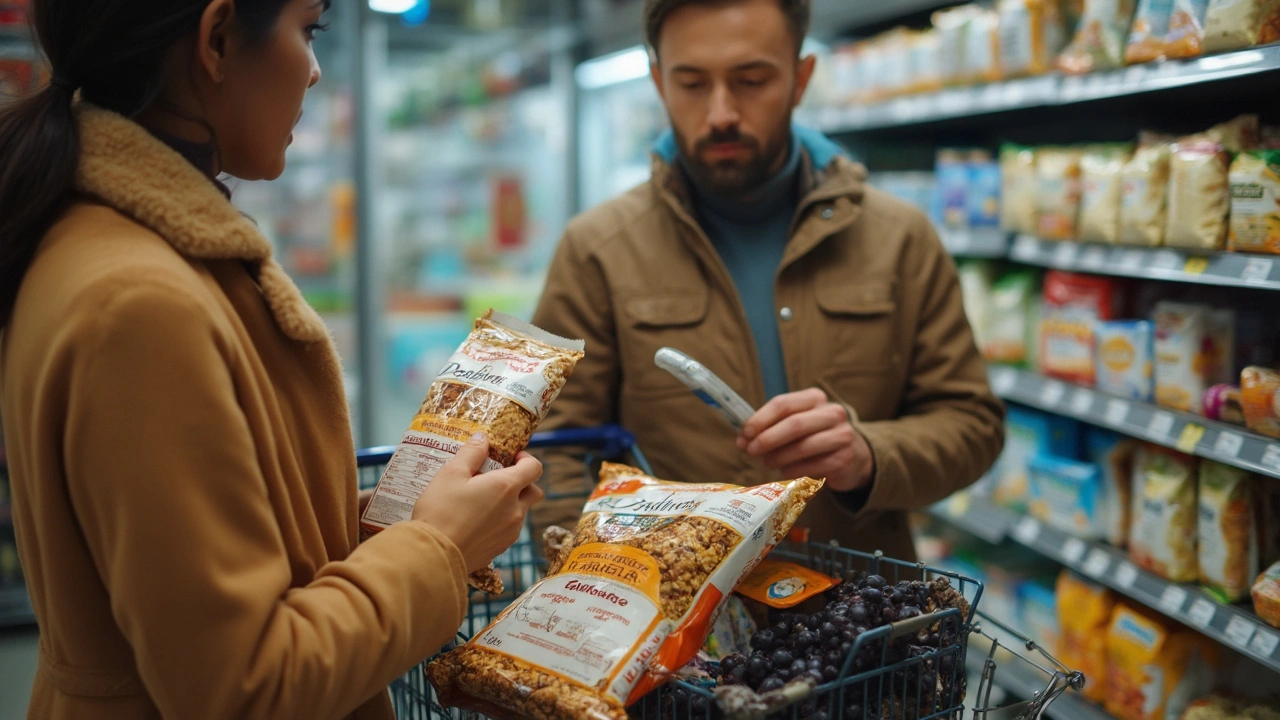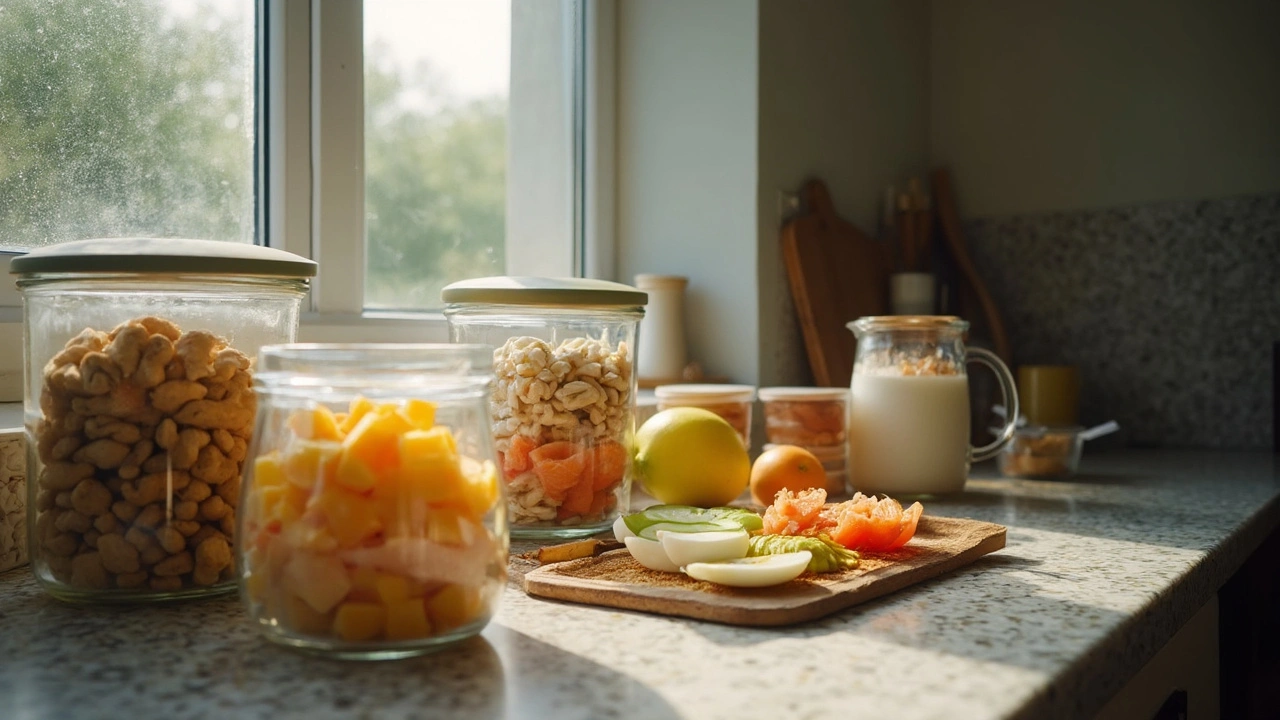Australians get a big chunk of daily kilojoules from discretionary foods, according to national nutrition surveys. That’s the gap to close. If you pick healthy snacks on autopilot, you’ll steady your energy, protect your training, and make weight goals feel easier-without living on lettuce or spending hours in the kitchen.
Here’s what I promise: quick, realistic options you can find at Coles, Woolies, ALDI, or your local markets; clear rules of thumb; and a tiny prep routine that saves you during crazy weeks. Zero guilt. Just food that works.
TL;DR
- Use the PFF formula: Protein + Fibre + (a little) Fat. Aim for 10-20 g protein, 5+ g fibre, and 800-1250 kJ (190-300 kcal) per snack.
- Pick snacks based on timing: light carb before workouts; protein-forward after; balanced between meals.
- Label shortcut (AU): Sugar < 10 g/100 g, Sodium < 120 mg/100 g, whole foods high on the ingredients list. Health Star Ratings help but aren’t perfect.
- Stock a snack station: Greek yoghurt, fruit, nuts, boiled eggs, wholegrain crackers, hummus, veg sticks, frozen berries, popcorn.
- Plan 15 minutes weekly: wash/chop, portion nuts, boil eggs, bake chickpeas, freeze smoothie packs. That’s your safety net.
The Healthy Snack Formula: What to eat and why it works
A snack should help you bridge the gap-not blow out your day. I use one simple formula: PFF, which stands for Protein + Fibre + (a little) Fat. It keeps you full, steady, and less snack-hunt-y at 3 pm. Here’s how to build it without thinking too hard.
- Protein: 10-20 g per snack (yoghurt, eggs, tuna, cottage cheese, tofu, edamame, legumes, protein yoghurt/bars).
- Fibre: 5+ g (fruit with skin, berries, veg sticks, wholegrain crackers, oats, legumes, chia, popcorn).
- Fat: small amount (nuts, seeds, olive oil, avocado, tahini). Enough for satisfaction, not a calorie dump.
Rules of thumb that actually hold up:
- Energy: 800-1250 kJ (190-300 kcal) is the sweet spot for most adults between meals.
- Added sugar: Keep it < 10 g per snack. Naturally occurring dairy/fruit sugars are fine; watch syrups and concentrates.
- Carb quality: If you need long-lasting energy, pick low-GI carbs (oats, grainy crackers, apples). The University of Sydney’s GI research backs this for steadier blood glucose.
- Sodium: Aim for < 120 mg/100 g to keep salt in check (the Heart Foundation uses this benchmark for “low” sodium).
Why it works: Protein and fibre increase satiety hormones and slow digestion. Randomised crossover trials show higher-protein snacks reduce later energy intake compared with high-carb options. The Australian Dietary Guidelines also emphasise whole foods and limiting discretionary choices-snacks are the easiest place to apply that.
Build-it-fast template:
- Pick a protein base: Greek yoghurt, cottage cheese, boiled eggs, tuna pouch, edamame, lupin flakes, tofu bites.
- Add fibre: fruit, veg sticks, wholegrain crackers, oats, popcorn, legumes.
- Add a small fat: nuts, seeds, avocado, tahini, olive oil drizzle.
- Add flavour: cinnamon, lemon zest, herbs, cacao, Vegemite, chilli, lime.
Decision guide when you’re busy:
- Hunger in under 2 hours until the next meal? Go lighter: fruit + yoghurt or rice cakes + cottage cheese.
- 3-4 hours until the next meal? Go full PFF: tuna + grainy crackers + veg sticks.
- Pre-workout (30-60 min)? Lower fibre, easy carbs: banana or yoghurt pouch.
- Post-workout (within 2 hours)? 20-30 g protein + some carbs: protein yoghurt + fruit, or cottage cheese + toast.
Grab-and-Go Snack Ideas for Home, Work, and Travel
No chef skills required. These are Aussie supermarket-friendly and quick to assemble. Mix and match to fit your preferences and budget.
- Greek yoghurt (170-200 g) + berries + a sprinkle of oats.
- Apple or pear + 30 g almonds (about a small handful).
- Cottage cheese on grainy toast with tomato, pepper, and a swipe of Vegemite.
- Tuna pouch (springwater) + wholegrain crackers + cucumber rounds.
- Edamame (microwaved from frozen) + tamari splash + sesame seeds.
- Hummus (2 tbsp) + carrot/celery/capsicum sticks + a few seed crackers.
- Boiled eggs (2) + cherry tomatoes + a mandarin.
- Protein yoghurt (YoPRO/Chobani Fit) + banana.
- Popcorn (air-popped, 3 cups) + a slice of cheese or a small kefir.
- Wholegrain Vita-Weat + avocado + smoked salmon or chickpea smash.
- Overnight oats jar: oats, chia, milk or soy milk, frozen berries, cinnamon.
- Trail mix: almonds, walnuts, pepitas, a few dark choc chips-pre-portion to 30 g.
- Roasted chickpeas (homemade) + a small piece of fruit.
- Tofu cubes (pan-seared) + edamame + chilli-lime dip.
- Nut-free school-safe: seed butter (tahini/sunflower) on rice cakes + cucumber; yoghurt + fruit; cheese + corn thins.
Travel/desk drawer savers:
- Plain protein bar (look for 15-20 g protein, < 6 g sugar, short ingredients list).
- Roasted fava or broad beans (portion packs).
- Ocean tuna pouch + mini rice cakes.
- Long-life milk/protein milk + fruit cup (in juice, not syrup) or sultanas.
Here’s a quick nutrition snapshot. Numbers are estimates-brands vary.
| Snack | Portion | Protein (g) | Carbs (g) | Fat (g) | Fibre (g) | Energy (kJ) | Prep | Approx. Cost (AUD) |
|---|---|---|---|---|---|---|---|---|
| Greek yoghurt + berries + oats | 180 g + 80 g + 1 tbsp | 17 | 25 | 5 | 5 | 1050 | 2 min | $2.20 |
| Apple + almonds | 1 med + 30 g | 6 | 24 | 14 | 7 | 1050 | 1 min | $1.50 |
| Cottage cheese on grainy toast | 2 slices + 100 g | 20 | 30 | 6 | 6 | 1200 | 5 min | $1.80 |
| Tuna pouch + crackers + cucumber | 95 g + 4 + 100 g | 20 | 20 | 5 | 5 | 1100 | 2 min | $2.50 |
| Edamame + tamari | 150 g cooked | 16 | 12 | 6 | 8 | 900 | 4 min | $1.20 |
| Hummus + veg + seed crackers | 40 g + 150 g + 3 | 7 | 20 | 9 | 6 | 1000 | 5 min | $1.70 |
| 2 boiled eggs + cherry tomatoes | 2 + 150 g | 12 | 3 | 10 | 2 | 850 | 7 min | $1.60 |
| Protein yoghurt + banana | 160 g + 1 med | 20 | 30 | 1 | 3 | 1050 | 1 min | $3.00 |
| Air-popped popcorn + cheese | 3 cups + 25 g | 9 | 20 | 8 | 5 | 1050 | 5 min | $1.00 |
| Avocado + smoked salmon on Vita-Weat | 1/4 avo + 40 g salmon + 4 | 12 | 20 | 12 | 6 | 1250 | 4 min | $2.80 |
| Overnight oats (oats/chia/berries) | 1 small jar | 12 | 35 | 8 | 9 | 1300 | 5 min (prep) | $1.40 |
| Roasted chickpeas + mandarin | 40 g + 1 | 7 | 22 | 3 | 6 | 950 | 15 min (batch) | $0.90 |
Pre/post-workout tweaks:
- Before training (30-60 min): banana, yoghurt pouch, or rice cakes with honey-easy carbs, low fibre.
- After training (within 2 hours): protein yoghurt + fruit, tuna + crackers, or smoothie with milk/soy milk + frozen berries + whey/pea protein.

Portion Sizes, Timing, and Label Decoding (Australia)
Portion sanity check:
- Nuts/seeds: 30 g (a small cupped handful).
- Cheese: 25-30 g (matchbox-sized).
- Yoghurt: 170-200 g tub.
- Hummus: 2 tbsp (about 40 g).
- Crackers: 3-5 grainy pieces, not the whole sleeve.
- Fruit: 1 medium apple/banana, or 2 small mandarins/kiwifruit.
Timing rules that reduce grazing:
- Space snacks 3-4 hours from main meals. Eat enough at meals so you’re not chasing food all day.
- Pre-workout: 15-30 g quick carbs if your last meal was 3+ hours ago.
- Post-workout: 20-30 g protein to support recovery; add carbs if the session was long or intense.
- Evening: if you need something, go protein-forward and lower sugar (e.g., Greek yoghurt with cinnamon, cottage cheese with berries).
How to read Australian labels fast:
- Always check per 100 g first, then serving size. Companies play games with tiny serves.
- Ingredients are listed by weight. If sugar, syrups, or refined starches are near the top, skip.
- Targets for snacks: sugar < 10 g/100 g (allow more if it’s mostly fruit/dairy), fibre > 5 g/100 g, sodium < 120 mg/100 g.
- Health Star Rating can guide a quick shelf scan, but still read the panel-some high-star foods are ultra-processed.
- GI Symbol (from the Glycemic Index Foundation) can help if you need steadier energy or manage blood sugar.
Added sugar aliases to watch for: dextrose, maltodextrin, fruit juice concentrate, barley malt, golden syrup, rice syrup. If three forms are sprinkled through the list, it’s a strategy to hide total sugar.
Note: The Australian Dietary Guidelines (NHMRC) still recommend mostly whole foods and limiting discretionary (energy-dense, nutrient-poor) choices. That’s exactly what these snacks deliver.
Pantry, Fridge, and Prep: Build Your 15-Minute Snack System
When the good stuff is ready to grab, you’ll actually eat it. Build a snack station once a week-I do this on Sunday arvo in Perth, right after a shop-and the whole week runs smoother.
Pantry checklist:
- Wholegrain crackers (Vita-Weat, Ryvita), brown rice cakes, popcorn kernels.
- Nuts and seeds (almonds, walnuts, pepitas, chia), 30 g zip-lock portions.
- Tuna or salmon pouches; roasted broad beans or chickpeas (or DIY).
- Oats, lupin flakes (WA-grown, high-protein), cinnamon, cocoa.
- Protein bars you’ve vetted; long-life milk or protein milk for emergencies.
Fridge/freezer checklist:
- Greek or protein yoghurt; cottage cheese; kefir.
- Eggs (boil 6-10 at once); hummus or tahini; avocado.
- Cut veg sticks (carrot, capsicum, cucumber, celery); cherry tomatoes; baby cucumbers.
- Seasonal fruit (mandarins in winter, mango in summer, Aussie apples and pears most of the year).
- Frozen berries, edamame; smoothie packs (berries + spinach + banana slices).
15-minute weekly routine:
- Wash and chop veg; store upright in containers with a splash of water so they stay crisp.
- Boil eggs (7-8 minutes), shock in cold water, peel, and box.
- Portion nuts/seeds into 30 g bags; stash a few in your work bag or glovebox.
- Roast chickpeas (drain, dry, drizzle oil, spice, 200°C for 15-20 min).
- Load 3-4 overnight oats jars; freeze two if needed.
- Make smoothie packs and freeze; blend with milk or soy milk when needed.
Budget tips in 2025:
- Buy in-season fruit/veg; frozen berries are usually cheaper per serve.
- Go home-brand Greek yoghurt tubs; they’re often great quality.
- Aldi for nuts and seed crackers; markets for produce later in the day.
- Use lupin flakes (WA bonus) to boost protein/fibre in yoghurt or oats.
Flavour boosters that keep calories low: lemon or lime, chilli flakes, sumac, dukkah, smoked paprika, cinnamon, vanilla, fresh herbs, Vegemite (small swipe for umami), a drizzle of olive oil.

FAQ and Real-World Fixes
Q: I snack a lot at night. What should I do?
Try a proper dinner with protein + veg + wholegrains. If you still want something, go protein-forward and lower sugar: cottage cheese with berries, or yoghurt with cinnamon. Brush your teeth after. If late snacking is a habit, set a kitchen close time and keep only pre-portioned options visible.
Q: Are protein bars actually okay?
They’re fine as a backup, especially when travelling. Choose 15-20 g protein, < 6 g sugar, < 3 g saturated fat, and a list you can read. If sugar alcohols upset your gut, skip those or limit to half a bar.
Q: Nuts are calorie-dense. Won’t they make me gain weight?
Not if you stick to 30 g. Multiple cohort studies show regular nut intake isn’t linked with weight gain and may help with appetite control. Pre-portion them so you don’t accidental-handful your way through the bag.
Q: Smoothie or juice?
Smoothie. You keep the fibre, which blunts the blood sugar spike and boosts fullness. Use milk or soy milk for protein, add berries or half a banana, and keep serve size to a small glass if weight loss is the goal.
Q: What about artificial sweeteners?
Food Standards Australia New Zealand approves them as safe within Acceptable Daily Intakes. If they help you cut sugary drinks or desserts, that can be a net win. Still, tune in to appetite-some people find sweet tastes keep cravings alive.
Q: I train early and can’t face food. Ideas?
Go tiny and simple: a few sips of milk or a small yoghurt pouch, or half a banana. After the session, get 20-30 g protein plus some carbs within two hours.
Q: My kid’s school is nut-free. What snacks work?
Seed butter (tahini or sunflower) on rice cakes, yoghurt + fruit, cheese + corn thins, hummus + veg sticks, roasted chickpeas, mini tuna tin with crackers (check school policy on tins).
Q: I’m trying intermittent fasting. Do I need snacks?
Maybe not. If you snack, put them inside your eating window. Break the fast with protein + fibre to avoid a sugar crash (eggs + veg, yoghurt + berries).
Next steps and troubleshooting by scenario
- Busy office worker: Stock a desk drawer (tuna pouch, seed crackers, roasted broad beans). Keep a yoghurt in the work fridge. Schedule a 3 pm snack to dodge vending machine raids.
- Gym-goer: Pre-workout banana in your bag. Post-workout protein yoghurt or a shake with milk/soy milk + frozen berries. Add grainy crackers if the session was long.
- Parent on the run: Prep veg sticks and hummus cups on Sunday. Keep fruit bowls at eye level. Pack two ready snacks per kid for after sport.
- Uni student on a budget: Oats + milk + chia + frozen berries does half your week. Eggs and frozen veg save dinner and tomorrow’s snack.
- Shift worker: Two small PFF snacks beat one giant one at 2 am. Keep a protein yoghurt and fruit cup handy. Hydration often fixes “snackiness.”
If something isn’t working, change one lever at a time: increase protein to 20 g, swap high-GI carbs for lower-GI, or tighten serve sizes. If you’ve got a medical condition (e.g., diabetes, kidney disease, GI disorders), run choices past your GP or an Accredited Practising Dietitian.





